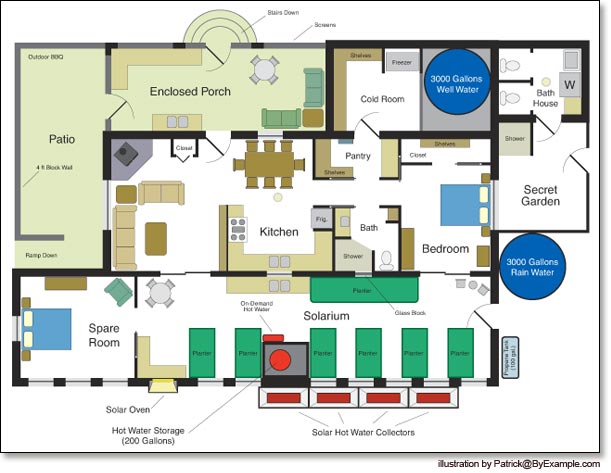Our Passive Solar House Plans - Version 2
Now that spring is here we are ready to start building our future home in earnest. However, the cheap or free single wide that we planned around in the first version of our house plans does not seem to be materializing. We've reconsidered our options and have developed house plans for a structure that we can build in phases and will ultimately have passive solar qualities.
While a single wide would have given us more space with fewer permitting fees and lower taxes, we have become very excited about building our own solar home from the ground up. To keep our taxes low we have settled on a plan that has the smallest footprint as possible, but will still meet our long term living needs. The initial core structure will be permitted at 820 sq. ft. Many of our later additions will be for agricultural use and as far as we can tell will not need permits in Apache County. We'll consider the features of future additions in regards to permitting and requirements as we approach each construction phase. Once phase four of our plan has been completed we'll have about 1600 sq. ft. of interior space for living and food production.
Click here to view our current house plans in PDF format.
Construction Materials
We'd love to build our passive solar home from a material that is completely environmentally friendly like strawbale or adobe, but these building methods have several drawbacks which have caused us to consider other construction methods.
Strawbale
Unfortunately permits are not granted for structural strawbale in Apache County and stick frame construction with strawbale infill is considerably more costly. With strawbale construction our taxes would also be higher because the exterior dimensions are used to calculate square footage. With 24 inch thick strawbale walls, we would be taxed for more than a hundred sq. ft. that is not living space, but would be occupied by our walls. Furthermore, construction approved straw bales are not locally available and would have to be imported from another area. Strawbale is not fireproof and free range cattle have also been known to find strawbale homes tasty. One of the major drawbacks to strawbale construction is that we could not devise an economical solution for under home storage and crawl space. It is also more difficult to build in phases with strawbale and a larger investment would be required in the initial stages. Strawbale is not a commonly accepted building material in our county and we are concerned that we could encounter unforeseen issues with permitting.
Adobe
Adobe construction is highly desirable because it utilizes local materials. However, there are no local sources for pre-made adobe bricks, and pre-made bricks are also quite costly. Adobe bricks would have to be imported from central New Mexico or southern Arizona, and transportation fees are not affordable. In addition, making adobe bricks entails a lot of labor, more than we can do ourselves before next winter. Eventually we may experiment with making our own adobe bricks, but most likely not until we've moved out of the travel trailer. Another concern with making our own adobe bricks is that they must pass stringent tests before construction permits will be issued. Adobe walls may also need to be as much as 16 inches thick to pass inspection in Apache County. Furthermore, adobe building methods are not widely used in our county and we could encounter unforeseen issues with permitting.
Adobe-Filled Cinder Blocks
Cinders are locally available and cinder blocks are manufactured within 100 miles of our home. Local sand can be used to fill in the cinder blocks to increase the overall thermal mass of our home. In addition, wood for plank floors can be obtained from a local saw mill. Cinder block construction is fireproof and our home will be suitable for a storm shelter as well. Because cinder block walls are 8 inches thick the overall footprint of our home will be minimized and our taxes reduced. Cinder block construction is relatively straightforward and we will be able to build quickly and economically without hiring skilled laborers. With adequate planning we should be able to build onto our core house with ease. Cinder block construction is widely used and accepted and we do not foresee any issues with permitting.
Construction Phases
We are planning to build in phases so that we can work within our current budget and still erect a suitable structure to live in by next winter. For more details on the features of our passive solar home, click here to view our previous house plans.
Phase 1
47.33 ft. x 17.33 ft. Concrete Block Core House (820 sq. ft.)
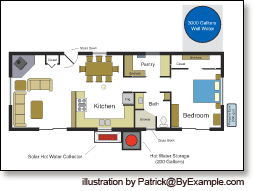 Room Dimensions
Room Dimensions
Living 14 ft. x 16 ft.
Dining 10 ft. x 8 ft.
Kitchen 12.5 ft. x 8 ft.
Pantry 10 ft. x 4.5 ft.
Bath 7.5 ft. x 7.5 ft.
Bedroom 10.75 ft. x 12.75 ft.
Walk-in Closet 10.75 ft. x 3 ft.
- 8" thick masonry walls, voids filled with local clay and sand
- key points reinforced with rebar and concrete
- insulated wood floor and 3'crawl space with concrete slab
- 3000 gallon well water storage tank on concrete pad
- painted outside, stucco inside
- interior space 46 ft. x 16 ft. (736 sq. ft.)
- flat roof (1/4:12) sloping to North
Phase 2
58.33 ft. x 12.66 ft. Solarium Addition
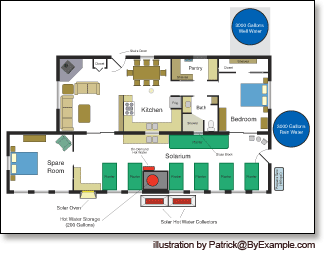
- 8" thick masonry walls, voids filled with local clay and sand
- key points reinforced with rebar and concrete
- painted outside, stucco inside
- interior space 57 ft. x 12 ft. (684 sq. ft.)
- flat roof (1/4:12) sloping to South
- insulated concrete slab floor (thermal mass)
- additional collector and on-demand hot water
- rain catch storage added and propane tank moved
Phase 3
19 ft. x 10 ft. Cold Room and 26 ft. x 10 ft. Enclosed Porch
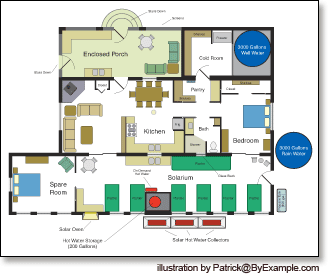
- 8" thick masonry walls, voids filled with local clay and sand
- key points reinforced with rebar and concrete
- painted outside, stucco inside
- flat roof (1/4:12) sloping to North
- additional hot water collector added
Phase 4
Outer Skin, 11 ft. x 10 ft. Bath House and 24 ft. x 11 ft. Patio
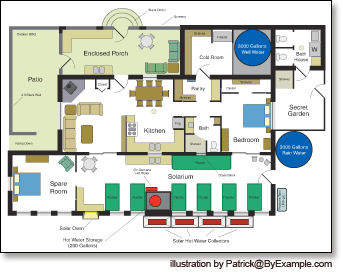
- 8" thick masonry walls covered with 2" styrofoam and stucco
- key points reinforced with rebar and concrete
- concrete slab floor on patio and bath house
- outdoor shower and secret garden added
- additional hot water collector added
- flat roof (1/4:12) sloping to East
Alternative Building Books
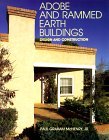 |
Adobe and Rammed Earth BuildingsPaul Graham McHenry, Jr. The University of Arizona Press, Tuscon, Arizona, 1984. If you want to build your own adobe house this book will provide you with detailed information on selecting soil and manufacturing your own adobe bricks. Many aspects of adobe home building are covered including appropriate foundation and roofing procedures, as well as methods for finishing earth walls. Though this book won't show how to build a rammed earth house, it does offer valuable information on a variety of earth building methods and includes details for building a rammed earth wall. |
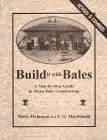 |
Build it with Bales Version 2Matts Myhrman & S. O. MacDonald. Treasure Chest Books, 1998. A Step-by-Step Guide to Staw Bale Construction - Originally published by Out on Bale, strawbale building techniques are clearly illustrated, while practical and humorous descriptions make this book a gem. Methods for constructing straw bale houses are explained for the beginner in understandable terms. This version of the book leads the builder from design to completion, making this book ideal for those who want to build their own strawbale houses. |
|
Visit the ByExample
Bookstore for more recommended books |
|
